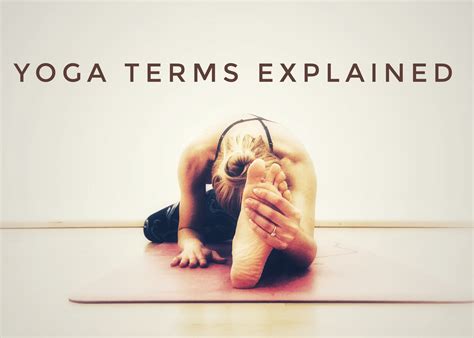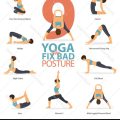Comprehensive Guide to Essential Yoga Terms: Understand Key Concepts and Master Your Practice
Yoga, a practice dating back thousands of years, encompasses much more than just physical poses. Its depth spans across philosophy, breathing techniques, and meditation, offering a holistic approach to health and well-being. For beginners and advanced practitioners alike, understanding essential yoga terms can significantly enhance the experience. This guide aims to break down the most important yoga concepts, providing both clarity and context. With a well-rounded grasp of these terms, your practice will become more meaningful, mindful, and accessible.
Introduction: Why Knowing Yoga Terms Matters
Yoga is more than just a workout; it’s a journey of the mind, body, and spirit. As yoga’s popularity grows globally, more people find themselves encountering Sanskrit terminology or philosophical concepts that are unfamiliar or confusing. Understanding these key terms is crucial for deepening your practice, improving communication with instructors, and embracing the broader spiritual and meditative aspects of yoga. This guide breaks down these essential terms into manageable sections to help make yoga accessible for everyone, from beginners to advanced practitioners.
Key Concepts
Yoga involves a variety of terms that encompass physical postures, breathing techniques, spiritual philosophies, and mental disciplines. Here’s a breakdown of the most essential yoga terms:
- Asana: Refers to the physical postures or poses practiced in yoga. These are the movements most associated with modern yoga practice, but they are just one aspect of the larger discipline.
- Pranayama: The control and regulation of breath, essential for achieving mental clarity and physical balance.
- Chakra: Refers to energy centers in the body, which align along the spine. There are seven main chakras, and they influence various physical, mental, and spiritual aspects.
- Mantra: A word, sound, or phrase repeated during meditation to focus the mind.
- Namaste: A respectful greeting, often used at the end of a yoga class, meaning “I bow to you” in Sanskrit.
- Vinyasa: A style of yoga characterized by linking breath with movement. The flow of poses is fluid and dynamic.
- Savasana: A restorative pose at the end of a session, also known as the Corpse Pose, used for relaxation and absorption of the practice.
- Kundalini: Refers to the primal energy, often visualized as a coiled serpent, located at the base of the spine. Kundalini Yoga focuses on awakening this energy for spiritual enlightenment.
Historical Context
Yoga’s origins can be traced back to ancient India over 5,000 years ago, as documented in texts such as the Rig Veda, one of the earliest religious texts of Hinduism. Initially, yoga was a spiritual and philosophical practice aimed at achieving union with the divine. It was only later that physical postures (asanas) became central to the practice, evolving into the globally recognized form of yoga that is practiced today. Patanjali’s Yoga Sutras, a 2,000-year-old text, provided the framework for what we understand as yoga, outlining the eight limbs of the practice, which encompass moral principles, posture, breath control, and meditation.
Current State Analysis
Yoga has grown into a global phenomenon, with millions of practitioners worldwide. However, in modern times, yoga’s physical aspect tends to be emphasized more than its philosophical or meditative roots. There’s a growing awareness that focusing solely on asana can leave out key components of the practice, such as pranayama and dhyana (meditation). Understanding these interconnected elements allows for a more holistic experience.
Types of Yoga
| Type of Yoga | Key Characteristics |
|---|---|
| Hatha Yoga | Focuses on basic postures and controlled breathing. Ideal for beginners. |
| Ashtanga Yoga | A rigorous, fast-paced practice that follows a specific sequence of poses. |
| Vinyasa Yoga | Emphasizes a flow of movements synchronized with breath. |
| Bikram Yoga | Performed in a heated room, this style includes 26 poses and two breathing exercises. |
| Kundalini Yoga | Focuses on awakening the spiritual energy within through poses, breathwork, and chanting. |
Practical Applications
Yoga can be applied across various aspects of life, from improving physical fitness to enhancing mental clarity. Here’s how understanding essential yoga terms can enhance your practice:
- Mindful Movement: Knowing the names and meaning of asanas helps practitioners move more intentionally, making the practice more meditative and less mechanical.
- Breath Control: Mastery of pranayama can lower stress, improve focus, and enhance overall physical performance.
- Energy Alignment: Familiarity with chakras enables practitioners to identify energy imbalances, promoting emotional and physical healing.
Case Studies
To illustrate the real-world benefits of yoga, we’ve included case studies from practitioners of various skill levels:
| Practitioner | Challenge | Outcome |
|---|---|---|
| Susan (Beginner) | Difficulty relaxing and sleeping | By incorporating savasana and pranayama into her evening routine, Susan significantly improved her sleep quality. |
| Mark (Intermediate) | Lack of mental focus during work | After practicing mindfulness and mantras, Mark noticed an increase in concentration and productivity. |
| Linda (Advanced) | Feeling stagnant in her practice | Linda shifted focus to Kundalini Yoga, awakening new spiritual insights and re-energizing her practice. |
Stakeholder Analysis
The popularity of yoga has drawn interest from various stakeholders, including health professionals, fitness centers, spiritual communities, and even corporate wellness programs. While some view yoga purely as a fitness regime, others emphasize its spiritual or meditative benefits. The fitness industry, in particular, has monetized yoga through specialized classes, apparel, and accessories, sometimes neglecting the philosophical roots of the practice.
Implementation Guidelines
To fully embrace yoga, consider the following implementation strategies:
- Start Slow: Beginners should focus on mastering basic postures and understanding their significance before diving into more advanced styles.
- Integrate Meditation: Balance physical poses with meditation and breathwork to ensure a well-rounded practice.
- Consistency is Key: Regular practice is essential for progress, so integrate yoga into your daily routine, even if only for a few minutes.
Ethical Considerations
With the widespread commercialization of yoga, ethical concerns have arisen, particularly around cultural appropriation and the dilution of yoga’s deeper spiritual meaning. It’s important to honor the origins of yoga by respecting its philosophical roots and ensuring that its sacred aspects aren’t reduced to mere trends.
Limitations and Future Research
While yoga is a powerful tool for physical and mental well-being, there are limitations. Some practitioners may experience physical strain or injury if poses are not performed correctly, while others may struggle to connect with the deeper spiritual aspects. Future research could explore ways to make yoga more inclusive and accessible to all populations, particularly those with physical limitations or mental health challenges.
Expert Commentary
Yoga is an evolving practice that continues to adapt to modern lifestyles while maintaining its ancient roots. Experts agree that understanding the terminology and philosophies behind yoga can deepen one’s practice and help balance the physical, mental, and spiritual benefits. By embracing both the philosophical and physical elements, practitioners can experience the full transformative power of yoga.








